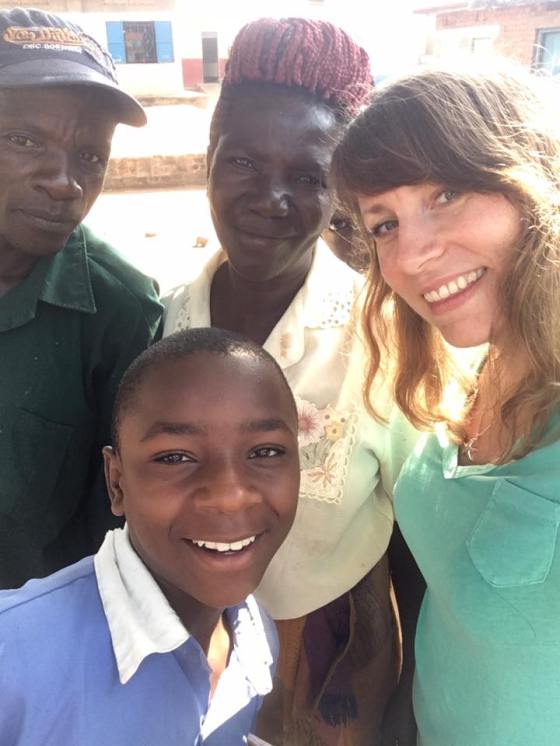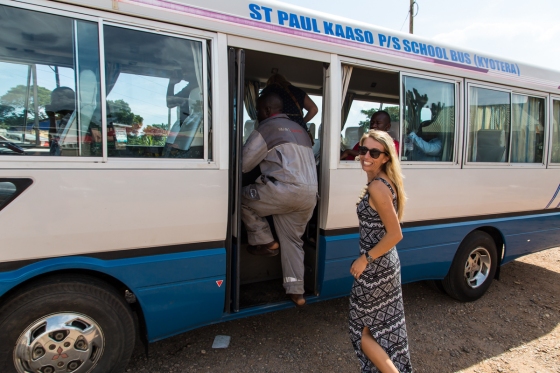Three months ago, I was hugely inspired by a conversation I had with a friend called Jessie. I was in Rio at the time in the lead up to the Olympic Games at which my husband was competing and life was all about sailing and sports. However, for a couple of hours one July afternoon, I was transported back to my village world during a Skype conversation with Jessie. Now back in the UK, Jessie shared with me the amazing updates from her recent trip to Uganda. I listened with a smile to her stories, her words reminding me so much of my own Ugandan experiences, but what struck a chord most was her talking about the ‘Starfish Story’ – a story so reminiscent of the motto of KAASO’s co-founder, Rose: “We can’t do everything, but we can do something.” I have just completed a memoir about this very issue – the fact that we so often feel paralaysed by inaction, the problems of the world seeming too big, unsurmountable, beyond us. However, for each and every person, a single act can make a huge difference. That was the case with me and Henry. And the same goes for Jessie. I invite you to read on and challenge you not to feel inspired…
Emma xxx
 I’m Jessie, a physiotherapist from the U.K. and this is my first ever blog. It’s taken a while for me to write but here goes… So why the ‘Starfish’ story? Well, it reflects some of what Uganda taught me. The main lesson – you can’t help everyone but we can all help someone.
I’m Jessie, a physiotherapist from the U.K. and this is my first ever blog. It’s taken a while for me to write but here goes… So why the ‘Starfish’ story? Well, it reflects some of what Uganda taught me. The main lesson – you can’t help everyone but we can all help someone.
The ‘Starfish’ story I know goes like this… There was a young girl walking along a beach with her mother and there were hundreds of starfish washed up on the sand. ‘What will happen to these star fish?’ asked the child. ‘Sadly,’ said her mother, ‘without the sea they will die.’ So the little girl started to pick up starfish as she walked along, throwing them back into the sea. Her mother said, ‘You can’t make a difference sweetheart, there are just too many of them.’ The little girl picked up another one and as she threw it back into the sea she looked up at her mother and said, ‘I can make a difference to that one!’
This story has always stuck with me and often helped me on crazy days at work or in life when I feel like I’m treading water and helping no one. On those days I take a deep breath and tell myself… One person at a time, the starfish effect!
UGANDA: Africa for me had always seemed a magical place I wanted to one day visit. I thought and daydreamed that maybe one day I could go and help a country that always seemed to be developing but, at the same time, struggling when I saw the images coming through on TV. Like many of us, I have limited funds so can’t address all the needs of a world that is crying out for help. It’s so easy to sit on a comfy sofa, feel sympathetic – and then hopelessly overwhelmed – and say to ourselves frankly, ‘What can I do?’ I’d donate £5 or £10 and hope it got to that kid with the sad eyes that desperately needed a hug, some love, some hope, all the things you can’t give from the comfort of your home.
Then, two years ago, I was asked to lead a team of sixteen-year-old boys who wanted to volunteer at a school in Uganda. I was super nervous, but I agreed to go. The boys raised money and, together with my parents, we ran a fund-raiser that got us all out there. So as soon as the boys finished their GCSEs, off we went, five boys and me to a rural school in the outback of Uganda. I had no idea what to expect – none of us did.
The first thing I discovered when we arrived was that Africa is not at all like what you see on the charity programmes. This was the first shock. Uganda is a very green and beautiful country, dusty from a lack of tarmac on the roads but so full of colour, life and beauty. The cities are crazy and full of life with everything from shanty towns to exclusive shopping centres. The rural areas are green and very beautiful. Not surprisingly, the sanitation isn’t great and while it’s not that hot, it is incredibly humid, which means the mozzies love the place. But overall, my first impression of Uganda was that it was an incredible country.

Our first challenge: of the 12 charity bags and 6 personal bags we had checked in, only two arrived which meant we had no clothes other than the ones we had on (and a few we later bought) for ten days. Needless to say, this was not part of the plan and it definitely made things slightly more interesting for the first week or so, however, this did not stop the boys getting involved with school life, and me getting involved with the small medical centre on the school grounds.
Towards the end of our stay, while the boys were playing sport with the kids during break time, I noticed one of the young boys sitting out. He was a good footballer and was normally one of the first to be out playing football so I was surprised to see him sitting on the side of the field. I went to check he was okay and he told me he was fine, he just had a sore foot. I hadn’t noticed him limping but I simply nodded and was about to leave him when I noticed his finger – it was raw. I asked him what happened but he refused to tell me until eventually, with the help of Jude, the school nurse, we managed to get the truth out of him. His answer literally stopped me in my tracks.
‘It’s from the rats,’ he said, ‘they come into the dorm at night and bite on our fingers and feet.’
I was so shocked. I asked why he hadn’t told someone. Jude gently explained that the boys didn’t want to get into trouble as the school is supposed to be a girl’s school and the boys are there mostly because they are siblings of orphaned girls with nowhere else to go so the Sisters who run the school have taken them in. The dormitory was a tiny, dark room with little comfort and in the rains it sometimes flooded. When the rats came in, they didn’t tell anyone for fear of being kicked out of the school.

I sat with him while Nurse Jude patched him up, then I went to explain to the boys I was with what was happening in the boys’ dorm. They were hugely upset to discover this and after some serious discussions about the situation, we made a decision: we would build a new dorm for the boys. Before leaving Uganda, we helped clean out the boys’ existing dorm and laid rat deterrent. We promised we would return.
Two years later, the boys had completed their ‘A’ Levels and managed to raise £8,000 which they sent over to the school to get construction underway. In July 2016, we all went back out to Uganda to paint the new dormitory and be there for when the young boys moved into their new home. It was an incredible moment and I am truly grateful to have been on this journey over the past two years. I am so proud of these five eighteen-year-old boys and the sustainable difference they have made to the school and the boys that currently live there. I hope this experience has inspired the boys in the dormitory and the girls of the school as well.


Nurse Jude was also waiting for us when we returned to Uganda and on this second trip, I learned more about his story. Jude is from a local family and was trained as an assistant nurse. He was employed by the school nurse but only qualified as an assistant nurse due to lack of funding. I thought back on the Starfish Story, and decided that this was one person I could help. With the assistance of friends and family, I am now funding him to become a fully trained nurse so he can further help his local community. There is a shortage of nurses and he is hoping to work at his local medical centre, the Busembatia Grade 4 Health Centre, once fully trained in a few years.

What Uganda taught me: There is a fragile balance in Uganda. On a basic level, most people we came across seemed to be doing well – they had food, great community spirit and clean water. Although life was simple and in no way easy, everyone wore huge smiles, no one complained, people were not starving and, on the most part, they were in good health – a far cry from what is portrayed on TV. However, when you look closer, you do see the problems that poverty brings – one mosquito bite and a child dies in its parents’ arms, unable to get to a medical centre that could provide free treatment if only they had the transport to get there. The failure of a single crop can mean the loss of a nutritional source, leading to malnutrition and illness. And yet the strength of the communities in the rural areas is inspiring.
The problems and fragilities in Uganda are huge and if you focus on the big picture, all you see is what you can’t do. Life can be overwhelming and complicated, however, if you keep things simple and look at the individuals around you, you realise that there are small things that can make a big difference. If we take a deep breath, find someone we trust and invest our efforts in small projects, we can lay a foundation so the people we help can then move on and help others. As in the Star Fish story, you can’t always help everyone, but if you can help and inspire the right people, then you can create a circle of goodwill that inspires the next generation and flows like ripples across a lake when you drop a stone.
Uganda taught me you can help people one by one, and that looking up and out, not down and in is the best way to help each other in this world.






















 I’m Jessie, a physiotherapist from the U.K. and this is my first ever blog. It’s taken a while for me to write but here goes… So why the ‘Starfish’ story? Well, it reflects some of what Uganda taught me. The main lesson – you can’t help everyone but we can all help someone.
I’m Jessie, a physiotherapist from the U.K. and this is my first ever blog. It’s taken a while for me to write but here goes… So why the ‘Starfish’ story? Well, it reflects some of what Uganda taught me. The main lesson – you can’t help everyone but we can all help someone.





